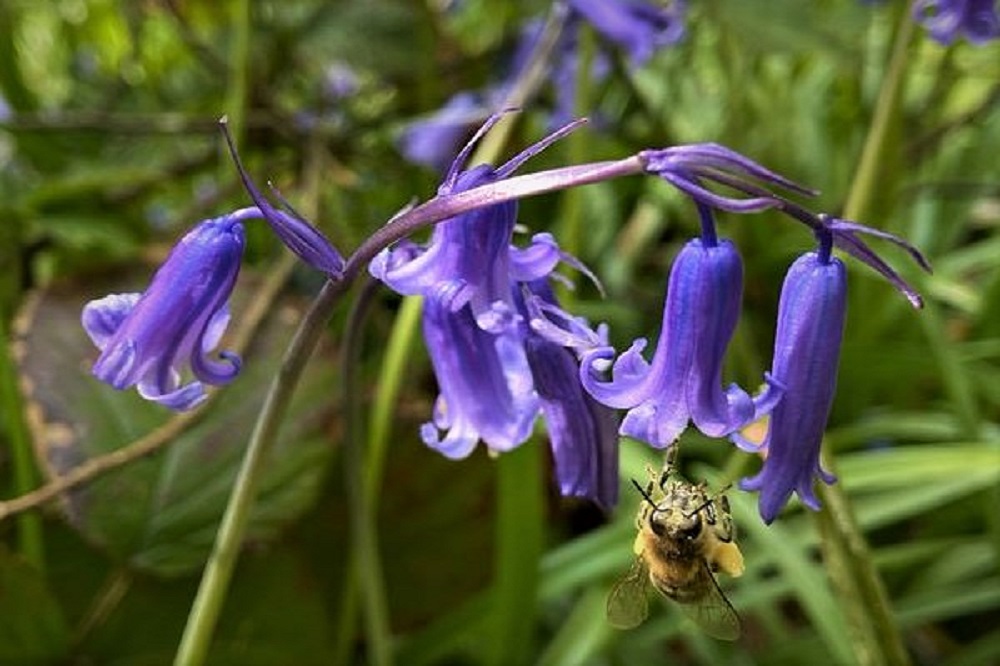Tawny Clark wanders and wonders among enchanted bluebells

Tawny Clark
Enveloped within a Cathedral of enlivened leaves, I find myself rooted to the ground. An uplifting choir of birdsong wraps about me like a beloved woollen shawl, and a heady heaven-scent sends my soul soaring into the sky.
I’m unable to move. Not because I can’t, but because in this moment there is nothing else in the world. Nowhere else to be. There is only this. This Present.
Such enthralled captivation at nature’s spectacle, this hypnotic state of life-affirming elation, can mean only one thing…bluebells.
A heart-stopping flood of deep lilac flows outwards across the forest floor. A profound euphoria builds from some unknown place within. Broadleaved trees burst into life in every direction across this enchanted realm.
Emerald-hued silks, satins, and velvets drape from every branch, every stem, shielding and cocooning the gasps and sighs of delighted wanderers. Although, I appear to be the only one this morning.
Shinrin-yoku, forest bathing, whatever you call it, the subliminal euphoria, the wonder, and visceral connection with the natural world is an innate part of humanness.
This otherworldly glade is the entirety of my present world. I’m lost to space and time. The million and one things I should be doing have vanished from my mind as I stand alone, drifting in and out of myself.
Blissful perfection
I meander aimlessly along the slender, winding paths, weaving between great, gnarled oaks and noble beeches – stopping to stroke and embrace their ancient bodies, or run my fingers through the tingling tendrils of silver birch saplings and sticky hands of sycamore as I pass.
Mature trunks are wrapped with ivy, insulated by moss and lichens, and alive with tits, thrushes and wrens which hop and flit among the branches. The excessive decibels of a robin nearly deafen me, as it announces my intrusion from its perch less than a foot from my eardrum.
Buttercup-yellow celandines and pink-blushed to milk-white wood anemones cling on in triumphant strongholds against the dominant pastel shade of bluebell. Bramble has begun to spread tentative shoots. It won’t be long until it cloaks the forest floor in an impassable layer of thorns and the secret of the bluebells will remain hidden inconspicuously beneath the leaf litter for another year.
To wander a bluebell wood in solitude is to know blissful perfection. It’s easy to see why ‘eco-therapy’ is a practice prescribed to improve mental health. Spending time in nature is about connecting, belonging, and importantly, remembering to breathe.
The charismatic, unrivalled champion of ancient woodland, the Common bluebell (Hyacinthoides non-scripta) – the nation’s favourite wildflower – like so many species of flora and fauna is under threat.
Nearly 50% of the entire world’s population of Common bluebell is found right here in the UK. Our woodlands truly are irreplaceable.

Witch’s thimble
The non-native Victorian introduction, the Spanish bluebell (Hyancinthoides hispanica), has long since escaped from garden collections into our countryside. It threatens to outcompete and hybridise with our native bluebell, bringing concern of genetic deterioration, and eventual extinction.
Time to admit defeat? Never! Recent research suggests the highly fertile Common bluebell stands a fighting chance against the lower fertility of competing bluebells – particularly hybrids.
We can help too. By treading with care and championing our woodlands. Legal protection prohibits picking flowers or uprooting bulbs so when it comes to Common bluebells, the simple message is to touch only with our hearts.
Whilst telling them apart can be tricky, some useful characteristics to look for are the native bluebell’s narrow leaves (1-1.5cm wide), flowers on a single side of the stem, and backward-curling flower tips.
It’s entirely unscientific, (so please refer to a reputable botany guide for purposes of accurate identification), but would it make a good fairy hat? If so, I’m afraid it’s likely a conical, or cap-shaped invader.
Despite sometimes being known as Fairy flower, the tubular bells of the native bluebell are closer in shape to slender Champagne flutes. They would make very foolish fairy hats indeed!
Another immanently better suited old name for the species is perhaps Witch’s thimble. And, from the continental shift which has occurred within me since stepping into these woods this morning, from troubled mind to one overflowing with peaceful serenity, I contemplate whether ethereal magic may indeed be at play. Has some ancient, transformative healing power been cast across this enduring, enchanted landscape?
Maybe I will never know the answer, but what I do know is that I’ll be back next year to breathe in this irreplaceable, unsurpassable spectacle of nature.
Support our Nation today
For the price of a cup of coffee a month you can help us create an independent, not-for-profit, national news service for the people of Wales, by the people of Wales.





Beautiful.
Lovely Tawny 👍🌿
Bizarre editorial choice.